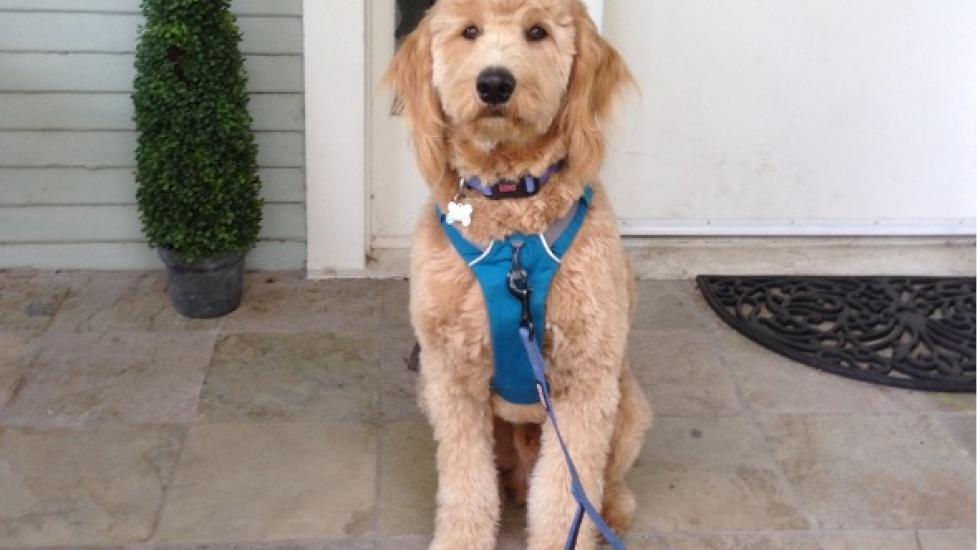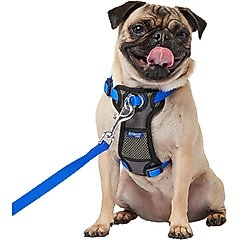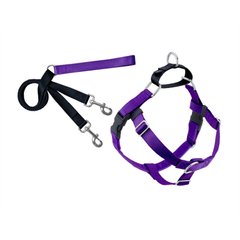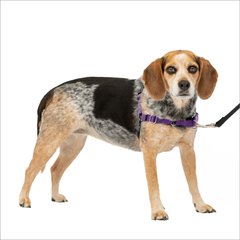How Do No-Pull Dog Harnesses Work?
Image via iStock.com/Mark Newton
By Linda Rodgers
“A dog that’s constantly pulling is frustrating for owners who just want to go on a nice, leisurely walk,” says Mary Huntsberry, a certified animal behaviorist and owner of Helping Pets Behave in Gaithersburg, Maryland.
If you find yourself being dragged on your daily walks, it might be time to consider your options when it comes to dog walking supplies. A dog harness made specifically to discourage pulling, for example, can help you gain more control on your walk and improve your pup’s dog leash skills. By using a no-pull dog harness, you can help make walks more enjoyable and prevent your dog from hurting herself.
Why Leash Pulling Can Be Harmful
If your pup is only wearing an ordinary dog collar, she can put a lot of tension on her throat as she strains forward, especially if you grip the leash or yank it back. This kind of pressure can hurt your dog’s neck regardless of her size, but especially if she belongs to a smaller breed.
“Little dogs can actually do a lot of damage to their very sensitive throats and trachea if they do excessive pulling,” says Mikkel Becker, certified dog trainer and resident trainer for FearFreeHappyHomes.com.
Excessive pulling can also lead to unwanted behaviors. Say your dog pulls whenever she sees another dog. If you hold her back, jerk the leash or drag her away, she begins to associate that unpleasant experience with other dogs.
“Dogs make associations with what’s happening in their environment and whatever they’re looking at, so from their perspective, seeing another dog predicts this unpleasant reaction from their owners,” Huntsberry explains. The result: Every time your dog sees another dog, she becomes uneasy and starts barking.
A no-pull dog harness helps end the leash battle between you and your dog so that you can have more peaceful walks.
How No-Pull Dog Harnesses Work
The best no-pull dog harnesses have straps that cross above your pup’s shoulders and can be fastened at center of your dog’s chest and behind her front legs, says Becker. The dog harness will also have a clip in front for the leash.
Once you clip the leash to the front ring and begin walking, your dog has to stay by your side in order to keep moving forward. If she does pull, the leash goes off to the side—not straight back—which directs your dog back towards you. That gives you greater ability to control and guide your dog back to your side by applying a little pressure, she adds.
Features to Look for in a No-Pull Dog Harness
Standard front clip. One dog harness option available is the PetSafe Easy Walk dog harness. Like other front-clip harnesses, it encourages you and your dog to engage in what trainers call loose-leash walking—when your dog walks by your side in a relaxed manner.
A front clip and back ring. Dog harnesses that have rings for clipping a leash on the back and front, like the 2 Hounds Freedom no-pull dog harness and leash, can minimize pulling. Becker explains that having a front and back ring means you can increase and decrease control as needed.
As your pup becomes more accustomed to loose-leash walking, you can graduate from using both the back and front rings to just the front ring and then just the back ring. Becker says another benefit is that “You can clip the leash to adjust to whatever situation you and your dog find yourselves—for example, a crowded sidewalk versus an open green space.”
Wider straps. If straps are thin and flimsy, the material is likely to chafe against your dog’s skin if she does pull toward something, says Huntsberry. “A thicker, wider strap is going to better distribute the pressure” so it doesn’t cut into your dog’s skin.
Some dog harnesses even have cushioning, like the Frisco padded front lead dog harness, which has wide straps as well as a front and back ring. Cushioning makes a harness even more comfortable for your dog, especially if you own a breed that doesn’t have much fur.
Recommended Products
How to Get Your Pet Used to a No-Pull Dog Harness
Ideally, you want your dog to see the harness as a good thing. Make sure to adjust the straps before you slip it on your dog, since you can accidentally pinch or make your pet uncomfortable if you adjust the harness while it’s on your dog, Becker suggests. You can also get your pup used to any buckling or clipping sounds by introducing them before you put on her harness.
Of course, when you slip the harness on, you’ll have to do some further tweaking, so be sure to reward your pup with dog treats during the process.
Will a No-Pull Dog Harness Stop Pulling Forever?
Think of the no-pull harness as a training tool. Yes, it will deter pulling on its own. But ideally, you’ll also be teaching your pet that a loose leash is the only way she’ll move forward, and a tight leash means she has to stop.
The key is to reward any positive behaviors. “If your dog checks in with you by looking in your direction or walks with her shoulder in line with your calf or thigh, reward the heck out of these behaviors,” Becker explains. “The more these go rewarded, the more likely they are to occur.” Rewards can include treats, but also your attention and slackening the leash.
Provide Mental and Physical Stimulation
It’s important to make sure your dog isn’t cooped up most of the day with nothing to do. If that’s the case, she’s probably going to pull more once she gets outside because she’s so eager to explore and interact with her environment, notes Huntsberry.
You want to give your dog mental and physical stimulation at home, she explains. So play games with your dog and give her appropriate things to chew on. You can offer her bully sticks to chew on or provide a dog interactive toy for her to discover treats. That may help her expend energy so she feels less of a need to pull when she gets outside.



